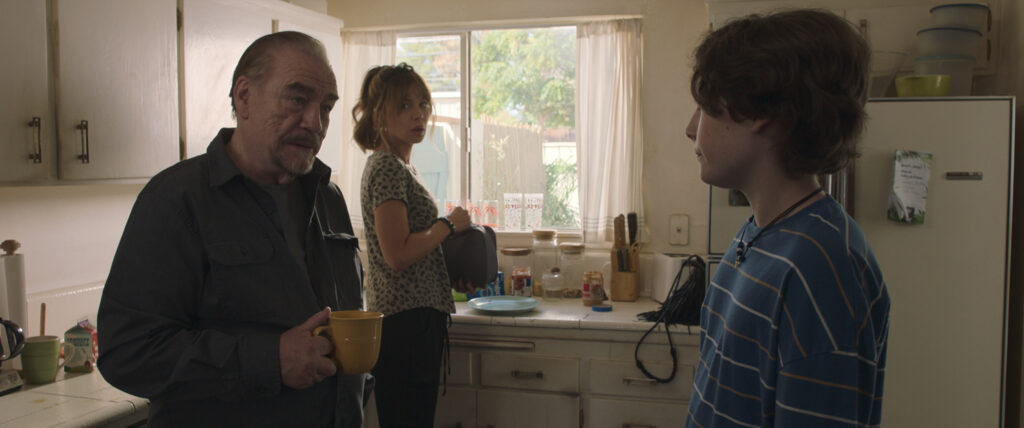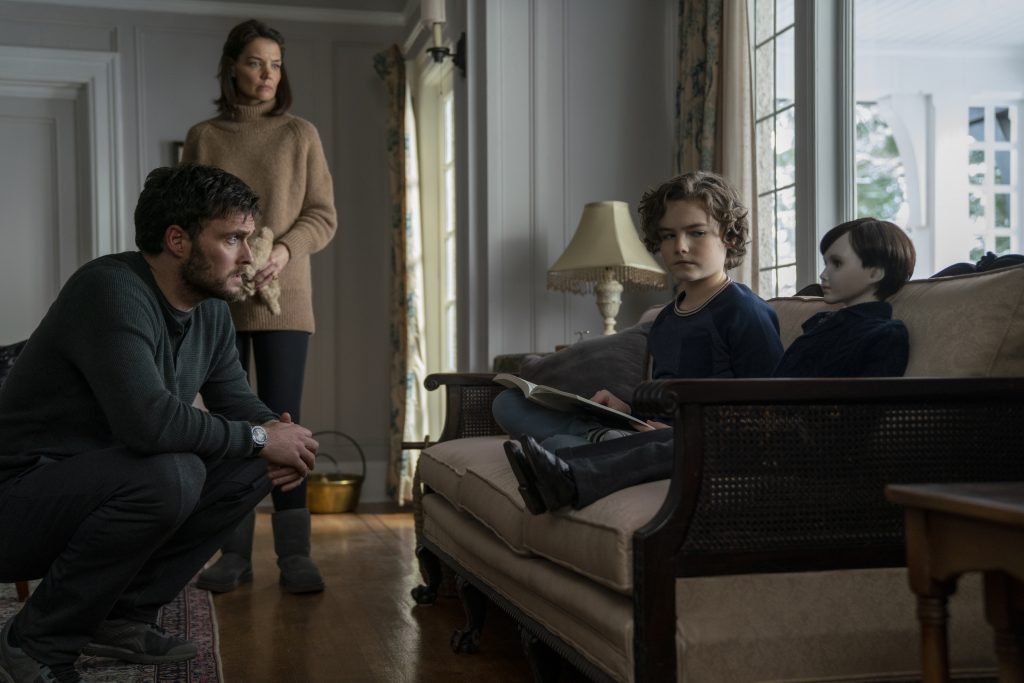July 21, 2023
by Carla Hay

Directed by Catherine Hardwicke
Culture Representation: Taking place primarily in Las Vegas, the dramatic film “Prisoner’s Daughter” features a predominantly white cast of characters (with a few African Americans, Asians and Latinos) representing the working-class and middle-class.
Culture Clash: An elderly man, who’s been in prison for violent crimes, is released early after he is diagnosed with cancer, and he goes to live with his estranged daughter and her son, while she has problems with her ex-husband, who’s a drug addict.
Culture Audience: “Prisoner’s Daughter” will appeal primarily to people who don’t mind watching formulaic dramas about estranged family members reuniting.

“Prisoner’s Daughter” holds viewers hostage with its relentlessly maudlin and predictable story. Brian Cox and Kate Beckinsale go through some very drab motions in this trite drama about a terminally ill criminal living with his estranged daughter. The movie is supposed to be emotionally intense, but the tone often veers into hokey melodrama, with much of it not believable at all. The movie’s dialogue is pedestrian at best. “Prisoner’s Daughter” had its world premiere at the 2022 Toronto International Film Festival.
Directed by Catherine Hardwicke and written by Mark Bacci, “Prisoner’s Daughter” (which takes place in Las Vegas) becomes more about the “prisoner” and less about the “daughter” as the movie lumbers along until its very sappy conclusion. Cox is the “prisoner”: a gruff cynic named Max “Buddy” MacLeary, who has been in and out of prison for violent crimes for most of his adult life. Max’s most recent stint in prison has been his longest: 12 years.
The story’s “daughter” is Max’s daughter Maxine, nicknamed Maxi (played by Beckinsale), who is an embittered, divorced mother who has cut off contact with Max for years because he’s been an irresponsible, mostly absentee father for most of her life. Maxine’s mother is deceased. Maxine, who works as a food server at a casual restaurant, is financially struggling and living in a modest house with her son Ezra (played by Christopher Convery), who’s about 13 or 14 years old. Maxine’s ex-husband/Ezra’s father is a drug-addicted musician named Tyler (played by Tyson Ritter), who’s a drummer in a rock band that’s going nowhere.
Near the beginning of the movie, it’s shown that Max has been diagnosed with cancer, so he is granted an early release from prison, but he’s still supposed to be under house arrest. In other words, the prison system didn’t want to pay for his cancer treatment, so prison officials let him go, but still want to have some control over him. Max is required to wear an ankle bracelet to keep track of his whereabouts. Jon Huertas has a small supporting role as the prison’s warden, whose name is Joseph.
Now that Max knows that he has a terminal illness, he wants to make amends with Maxine. As soon as Max is released, he pays an unannounced visit to Maxine, who is very unhappy to see him. Max expresses remorse for not being a good father. Max tells Maxine that he’s in the final stage of cancer, and he asks to live with her and Ezra. Maxine dislikes the idea, but agrees only if Max pays her rent.
Max, who used to be a semi-pro boxer in his youth, gets the money by going to his old boxing friend Hank (played by Ernie Hudson) and asking Hank to repay the money that Max lent to Hank years ago, so that Hank could open his own boxing gym. The gym is still operating. Hank is the chief trainer at the gym.
Maxine has been having conflicts with Tyler, who wants to spend more time with Ezra, but she thinks Tyler is too dangerous and too flaky to get more visitation rights. Expect to see several scenes of Tyler being aggressive and unstable while he’s high on whatever drugs he’s been taking. One of the few things that Maxine and Max agree on is that they both despise Tyler.
Meanwhile, Ezra happens to be living with epilepsy. He is a bright and sensitive child who is bullied at school. What’s an ex-boxer with a violent criminal record to do when his best friend trains boxers and his grandson is being bullied? You know where this is going, of course. Max is vague with Ezra about all the crimes that Max committed, but Max does admit to Ezra that he used to make money by beating up people for mobsters. Max also doesn’t deny it when Ezra asks if Max ever killed anyone.
The rest of “Prisoner’s Daughter” is a back-and-forth slog showing arguments of Max versus Maxine; Max versus Tyler; Maxine versus Tyler; and Tyler versus Max and Maxine. Ezra is often caught in the middle, while the adults often forget that Ezra’s needs, not their egos, should come first, although Maxine does make the best efforts out of the three adults to be a good parent. And you just know that big epileptic scene is coming, long before it happens.
Cox is doing yet another “tough old man” role. Beckinsale, no matter how hard she tries, is just not entirely convincing as a down-on-her-luck, working-class mother. Her scenes with Cox look too much like forced acting instead of being naturalistic. In real life, Ritter is the lead singer of the rock band The All-American Rejects, so he didn’t have to do much acting in portraying a musician. All of the cast members are, in one way or another, depicting not-very-interesting stereotypes with their “Prisoner’s Daughter” characters. It doesn’t help that the cast members have to say a lot of idiotic lines from the low-quality screenplay.
“Prisoner’s Daughter” is not the worst movie you could ever see. It’s just so lazy and unimaginative in its dialogue and story. The direction of “Prisoner’s Daughter” also lacks creativity and makes “Prisoner’s Daughter” look like one of those movies that gets dumped on a streaming service or third-tier cable network and is quickly forgotten. There are absolutely no surprises in “Prisoner’s Daughter,” which lays the melodrama on thick toward the end, but didn’t bother to make everything look authentic.
Vertical released “Prisoner’s Daughter” in select U.S. cinemas on June 30, 2023. The movie was released on digital and VOD on July 18, 2023.


